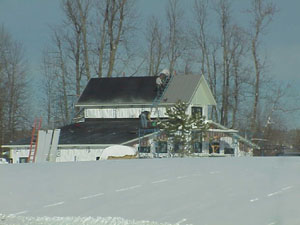Winter 2004 |
||||
| PREVIOUS|PAGE 1 | ||||
| "Green" Buildings as Functional Science Facilities Get Little Notice from Users Carol Budd |
||||
Saturday, in the Adirondack Park, it’s definitely NOT the 4th of July. A spate of minus 20 degree Fahrenheit weather has our hoods securely fastened, scarves tied, and pant legs tucked into boots. I just returned from presenting our Parents committee with the design diagrams of the new “green” field station that St. Lawrence University’s (SLU) Integrated Science Education Initiative (ISEI) was fortunate enough to design, permit, and contract out. To be honest, I was initially interested in just getting the facility up and running to relieve the overload in lab space resulting from increasing emphasis on investigative labs. As we progressed, the “greening” of the building became more intriguing to me. ISEI wanted to adopt the “green” building philosophy in its field station, constructed within the Little River Nature Research and Recreation Area adjacent to campus. (It has since been adopted by SLU for planning its new science facilities). ISEI had received a generous donation from a current student’s parents. Our field station concept was wedded to promotion of student/faculty research projects and teaching environmental science. What better venue for introducing students to “green” concepts and design strategies? A “green” building is designed to be environmentally responsible, profitable, and a healthy place to work. Conservation features include considerations of building use and location, energy conservation and renewable energy requirements, resource conservation, environmental benefits, and building durability issues. A recent study by the Capital E group, Lawrence Livermore Laboratory and participating California state agencies demonstrates that financial benefits of green buildings exceed costs by 10 to 1. The balance sheet includes materials; lower costs for energy, waste, and water; lower environmental and emission costs; and lower operational and maintenance costs, as well as increased productivity and health. Because our building was to be used as a very wet and dirty lab space to process specimens collected for observation and return to the local environs, we needed to include cement floors with drains and hoses to ease maintenance. Because our building was to be located in a 100-year floodplain, we needed to provide the U.S. Army Corps of Engineers (ACE) and the New York State Department of Environmental Conservation with extensive documentation including wetland delineation, engineering diagrams of any probable projects to be constructed in the next five years, NYS Parks and Recreation documentation for sensitive cultural areas, and National Heritage Program documentation of rare, threatened and endangered species -- and it all had to be shepherded. The three-year process resulted in exuberant ACE approval for our educational projects rather than a knock-down, drag-out argument with developers on responsible stewardship. What “green” features were engineered into our building?
In the past three days of minus 20 degree Fahrenheit temperatures in frigid northern New York, the field station has been the most comfortable building on campus. The building faces directly south and a large cupola the length of the building serves for passive solar gain. Internally, a series of heat sensors moves the air from the building heights to lower levels. In addition, a series of natural gas heated water conduits are embedded in the concrete slab and allow the floor to radiate heat. A series of interlocks from the entryway prevents cold external air from completely mixing with the internal air. Two heat exchangers prevent cold external air from entering. My presentation of the design to the Parent's Committee occurred after two other presentations on the design process for our new science facilities and an introduction to our science education initiative. In that both presenters had gone over and I was left with only a few minutes, I threw away my prepared spiel and simply asked the 34 parents in attendance if anyone had cold feet. No one responded affirmatively. In fact, many of them had stripped off layers of jacket, fleece and sweater, as the room was toasty warm. I then had them place their palms on the floor to feel the radiant heat coming from the cement slab. "Oohs" and "Aahs" filled the room because they were totally unaware of how one design feature had such a major impact on their level of comfort for the business at hand. My point is that they didn't notice that the building was "green". They probably would not have noticed if the building was standard construction either, as long as it met their needs. The students who have visited the building to date have stated “how nice” it is, without obvious recognition that it is the first "green" building on campus. Unless a person is focused on the design, the "green" design will probably go unnoticed. It just doesn't look different. The building is functional for its use. It will be warm and cozy in cold weather and cool and breezy during the hottest weather. The mess and moisture are easily confined, and the lab tables are spacious and comfortable. Undeterred by lack of notice, ISEI will post signage to document the building’s “green” features. To the end of promoting "green" building features at the community level, an annual locally organized Energy Fair has asked to tour the building as part of scheduled events this spring. Additionally, our local Traditional Arts of Northern New York group will be exhibiting a local carver’s passerine collection and has asked to use the station as a venue for leading bird walks. Over time, the building design will be accepted as “normal” and the documentation signage could probably come down. Lastly, can you guess what color the building is? Yup, green.
|
||||
| PREVIOUS|PAGE 1 | ||||
